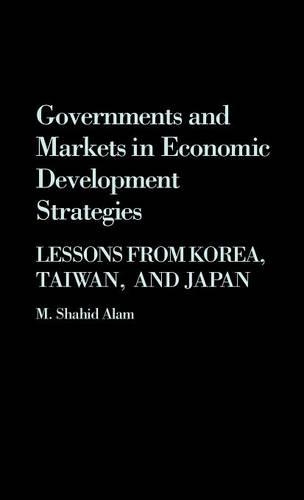
Governments and Markets in Economic Development Strategies: Lessons From Korea, Taiwan, and Japan
(Hardback)
Publishing Details
Governments and Markets in Economic Development Strategies: Lessons From Korea, Taiwan, and Japan
By (Author) M Shahid Alam
Bloomsbury Publishing PLC
Praeger Publishers Inc
12th June 1989
United States
Classifications
Tertiary Education
Non Fiction
Microeconomics
330.95
Physical Properties
Hardback
198
Description
Many social scientists have explored the economic success of Korea, Taiwan, and Japan, each of which has experienced dramatic economic growth over a relatively short period of time. M. Shahid Alam presents a controversial thesis by emphasizing the interventionist character of the export-oriented approach to the success of these three countries. Concern with the rapid development of comparative advantage in the industries they have promoted has, he believes, distinguished these three economies. This concern has led to both market and non-market interventions with the trade regime, capital markets, market structures, etc. The book explores how Taiwan and Korea changed from import substitution to the export-oriented approach with significant success. The point is made that export-oriented economies make more demands on the government, so that success in different countries cannot be assured. The book begins with an examination of export-oriented economies and the reasons for their success. Three separate chapters follow detailing the structure, choice and implementation of economic policies in South Korea, Taiwan, and Japan. Finally, the book assesses export-oriented strategies and their application to other countries. Students and scholars of economics, business, and political science, will find this thought provoking book a source of stimulating ideas. In addition, the book has the potential for being used as a text for graduate and advanced undergraduate courses on East Asian economics and comparative economic development.
Reviews
There has been a long-running debate among development economists with regard to the role of governments in the phenomenal economic growth of the East Asian countries. On the one hand, neoclassical economists maintain that their success can be attributed to the laissez-faire approach adopted by the respective governments and the export-oriented policies aimed at achieving more efficient allocation of resources through the harmonization of domestic and world prices. On the other hand, other development specialists challenge this line of argument and counter that these countries have employed active interventionist policies to promote selected export industries by creating dynamic comparative advantage in them. Alam attempts to substantiate the latter thesis with respect to three East Asian countries, namely Japan, South Korea, and Taiwan. This volume consist of five chapters. The first is exclusively concerned with the theoretical discourse between the two schools of thought. The next three chapters relate to the case studies of the three countries. The last chapter tries to answer the question whether the export-oriented strategy, so successful to these countries, can be adopted by other developing countries with an equal chance of success. The book is rather eclectic with no tables or quantification. The writing style is concise and to the point. Appropriate for academic collections.-Choice
"There has been a long-running debate among development economists with regard to the role of governments in the phenomenal economic growth of the East Asian countries. On the one hand, neoclassical economists maintain that their success can be attributed to the laissez-faire approach adopted by the respective governments and the export-oriented policies aimed at achieving more efficient allocation of resources through the harmonization of domestic and world prices. On the other hand, other development specialists challenge this line of argument and counter that these countries have employed active interventionist policies to promote selected export industries by creating dynamic comparative advantage in them. Alam attempts to substantiate the latter thesis with respect to three East Asian countries, namely Japan, South Korea, and Taiwan. This volume consist of five chapters. The first is exclusively concerned with the theoretical discourse between the two schools of thought. The next three chapters relate to the case studies of the three countries. The last chapter tries to answer the question whether the export-oriented strategy, so successful to these countries, can be adopted by other developing countries with an equal chance of success. The book is rather eclectic with no tables or quantification. The writing style is concise and to the point. Appropriate for academic collections."-Choice
Author Bio
M. SHAHID ALAM is currently teaching at Northeastern University and has taught at Colgate, Queen's, and Karachi Universities. He has published in the American Economic Review, American Journal of Economics and Sociology, Journal of Development Economics, Southern Economic Journal, and Economic Letters.
